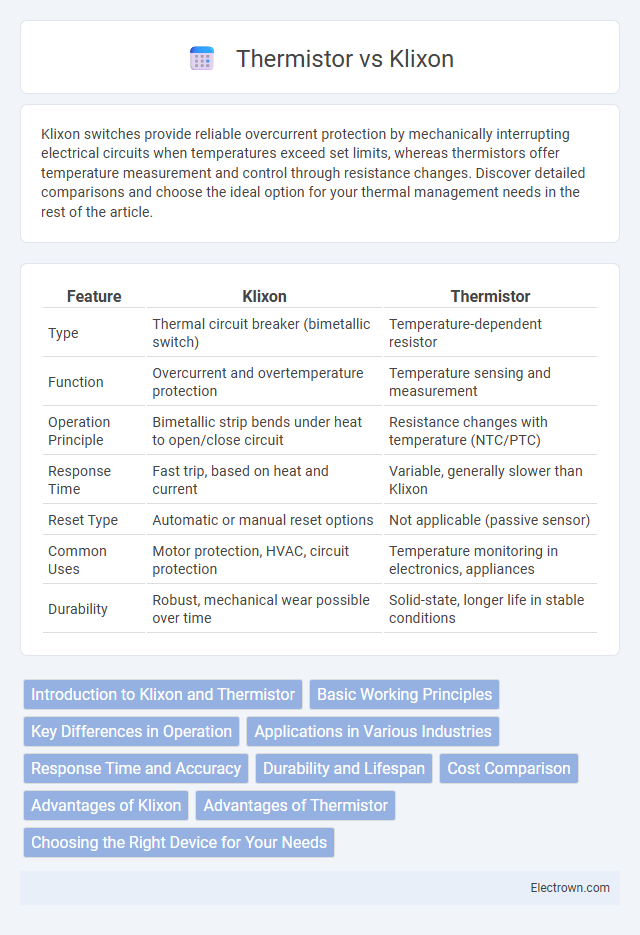Klixon switches provide reliable overcurrent protection by mechanically interrupting electrical circuits when temperatures exceed set limits, whereas thermistors offer temperature measurement and control through resistance changes. Discover detailed comparisons and choose the ideal option for your thermal management needs in the rest of the article.
Table of Comparison
| Feature | Klixon | Thermistor |
|---|---|---|
| Type | Thermal circuit breaker (bimetallic switch) | Temperature-dependent resistor |
| Function | Overcurrent and overtemperature protection | Temperature sensing and measurement |
| Operation Principle | Bimetallic strip bends under heat to open/close circuit | Resistance changes with temperature (NTC/PTC) |
| Response Time | Fast trip, based on heat and current | Variable, generally slower than Klixon |
| Reset Type | Automatic or manual reset options | Not applicable (passive sensor) |
| Common Uses | Motor protection, HVAC, circuit protection | Temperature monitoring in electronics, appliances |
| Durability | Robust, mechanical wear possible over time | Solid-state, longer life in stable conditions |
Introduction to Klixon and Thermistor
Klixon and thermistor are both temperature sensing devices used in various electrical and electronic applications to protect circuits from overheating. Klixon is a brand of bimetallic thermal protectors that mechanically disconnect the circuit at a specific temperature threshold, ensuring reliable thermal cutoff. Thermistors, on the other hand, are semiconductor-based resistors whose resistance varies significantly with temperature, enabling precise temperature measurement and control in your system.
Basic Working Principles
Klixon switches operate as bimetallic thermal protectors that break electrical circuits when temperatures exceed preset limits, utilizing the deformation of a metal strip to trigger contact separation. Thermistors function as temperature-dependent resistors, changing their resistance value significantly with temperature variations to provide precise temperature measurements or control. Both devices are crucial in temperature sensing but differ fundamentally in their operation: Klixon uses mechanical switching triggered by heat, while thermistors rely on electrical resistance changes for thermal detection.
Key Differences in Operation
Klixon switches operate as mechanical thermal protectors that open or close circuits based on temperature thresholds using bimetallic strips, providing rapid response and resettable operation. Thermistors function as temperature-sensitive resistors that change electrical resistance with temperature variations, enabling continuous temperature monitoring and precise control. The key difference lies in Klixon's switching action for on/off control versus thermistors' analog signal output for variable temperature measurement.
Applications in Various Industries
Klixon devices are widely used in automotive and HVAC systems for reliable over-temperature protection and motor control, while thermistors find extensive applications in consumer electronics, medical devices, and battery management systems due to their precise temperature sensing capabilities. In industrial settings, Klixon switches offer robust performance in heavy machinery and appliances requiring thermal cutoff functionality, whereas thermistors provide critical temperature monitoring in process control and environmental systems. Both components complement each other by addressing different thermal management needs across manufacturing, aerospace, and energy sectors.
Response Time and Accuracy
Klixon thermal protectors offer rapid response times due to their bimetallic strip mechanism that promptly reacts to temperature changes, ensuring quick circuit interruption in overheating conditions. Thermistors provide higher accuracy in temperature measurement with precise resistance changes correlated to temperature variations, enabling detailed monitoring and control. While Klixon devices excel in fast protective response, thermistors are preferred for applications demanding precise and continuous temperature sensing.
Durability and Lifespan
Klixon thermal protectors exhibit higher durability and longer lifespan due to their mechanical bimetallic design, which withstands frequent cycling and harsh environmental conditions better than thermistors. Thermistors, while sensitive and precise in temperature measurement, tend to degrade over time from thermal stress and electrical exposure, leading to shorter operational life. Industries requiring robust and reliable thermal protection often prefer Klixon devices for their proven longevity and resilience.
Cost Comparison
Klixon switches generally cost more than thermistors due to their mechanical components and precise thermal protection capabilities. Your choice impacts budget allocation, as thermistors offer an affordable, cost-effective solution for temperature sensing with simpler electronic applications. Evaluating long-term reliability and replacement costs is essential to determine the best fit for your specific temperature control needs.
Advantages of Klixon
Klixon switches provide precise temperature control and rapid response to overheating, ensuring superior protection for your electrical devices compared to thermistors. Their mechanical design guarantees reliable operation under extreme conditions and long-term durability without signal drift. Klixon's ability to reset automatically enhances safety and convenience in various applications, including motors and appliances.
Advantages of Thermistor
Thermistors offer higher sensitivity and precision in temperature measurement compared to Klixon switches, enabling accurate monitoring in electronic circuits. They provide a continuous range of resistance change rather than simple on/off operation, allowing for better control and responsiveness. Additionally, thermistors are compact, cost-effective, and have faster response times, making them ideal for applications requiring precise temperature regulation.
Choosing the Right Device for Your Needs
Klixon thermal protectors provide reliable, automatic reset capability ideal for motor and compressor protection in high-temperature environments, while thermistors offer precise temperature sensing with variable resistance suited for electronic temperature monitoring. Selecting the right device depends on whether the application demands simple overheat cutoff (Klixon) or accurate temperature measurement for feedback control (thermistor). Consider operating temperature range, response time, and system complexity to ensure optimal performance and safety.
klixon vs thermistor Infographic

 electrown.com
electrown.com